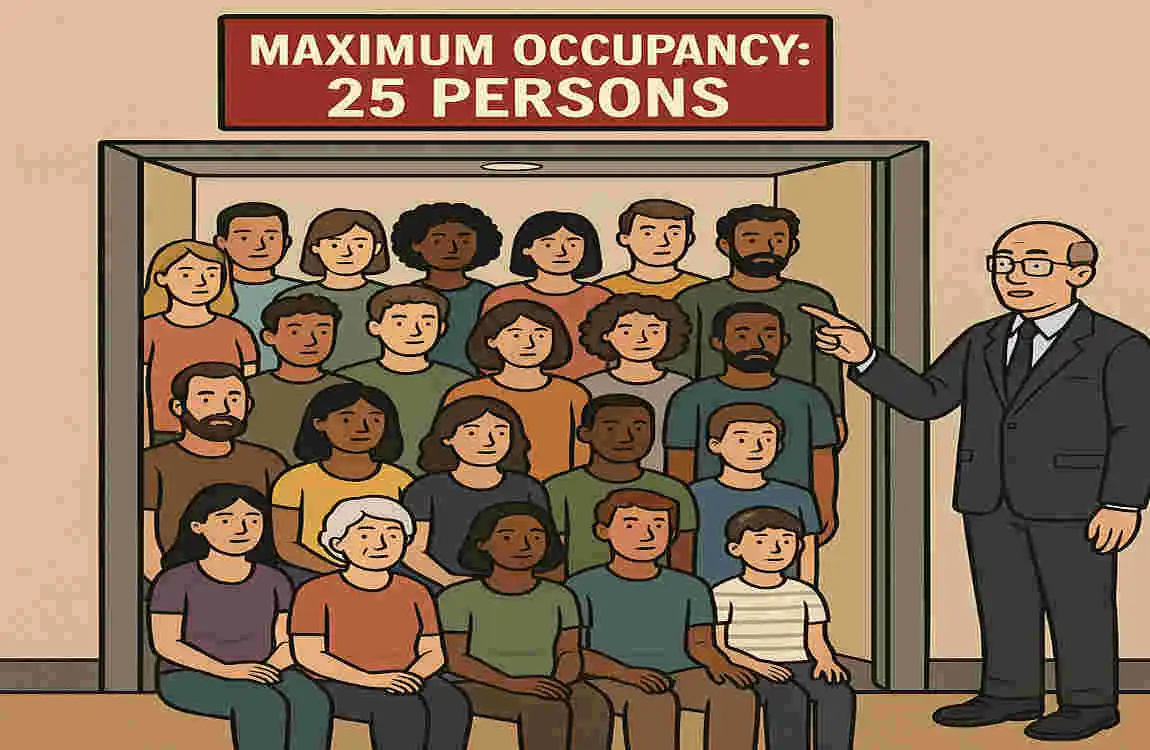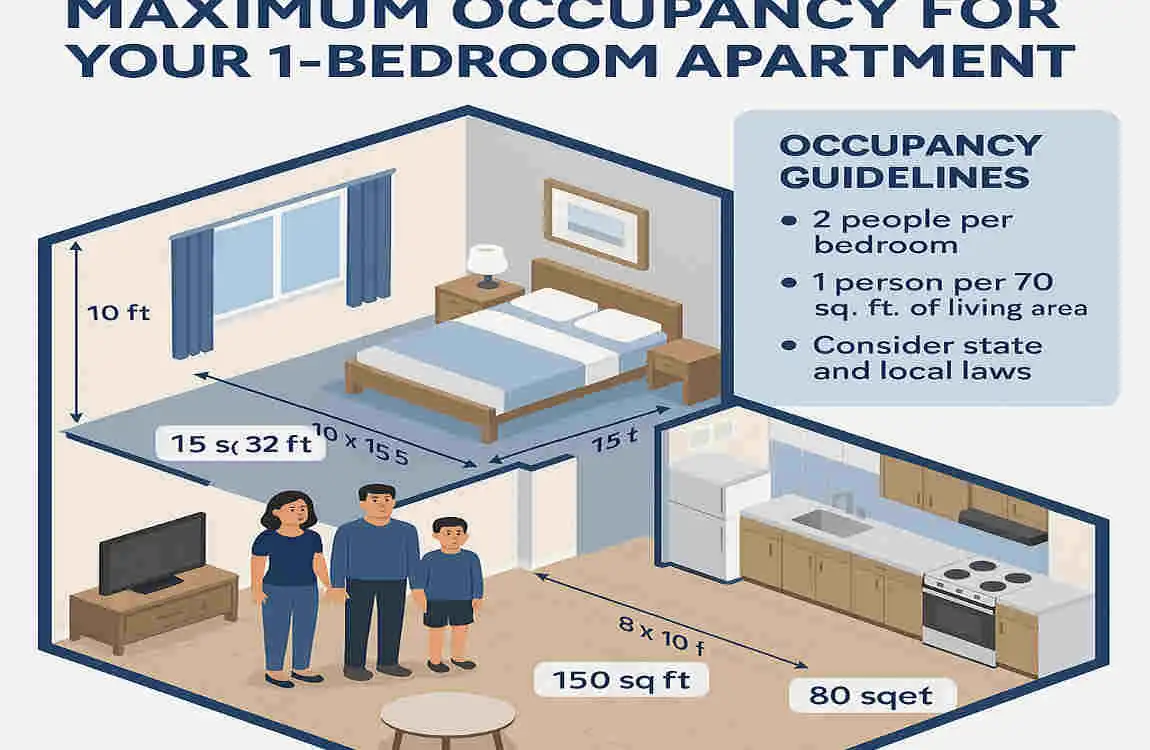If you’re wondering what the maximum occupancy for a 1-bedroom home apartment is, you’re not alone. Many renters, landlords, and property managers often find themselves confused or misinformed about this topic. Understanding these occupancy limits isn’t just about following rules — it’s about ensuring safety, comfort, and compliance with housing regulations..
What Does Maximum Occupancy Mean?

Defining Maximum Occupancy
Maximum occupancy refers to the legal limit on the number of people who can reside in a specific living space, such as a 1-bedroom apartment. These rules are designed to promote safety, ensure adequate living conditions, and prevent overcrowding.
For a one-bedroom apartment, the occupancy limit often depends on factors such as square footage, local housing laws, and building codes. This limit helps ensure that everyone living in the space has access to enough ventilation, privacy, and emergency exits.
What Factors Influence Maximum Occupancy?
Several considerations determine how many people can legally occupy a 1-bedroom apartment:
- Room Size and Square Footage:
- Many housing codes require a minimum square footage per person. For instance, some regulations stipulate that there must be at least 70 square feet of sleeping space per person.
- Local Housing Laws:
- Different cities and states set their own maximum occupancy limits. For example, some areas are stricter than others due to population density or safety concerns.
- Building Codes and Zoning Regulations:
- These codes determine the maximum number of people who can safely reside in a specific type of housing unit, typically based on fire safety, ventilation, and structural considerations.
The General Rule: 2-Person Per Bedroom
One common guideline in the United States is the “2-person per bedroom” rule. This means that a 1-bedroom apartment is typically suitable for two occupants. However, exceptions exist, especially for families with children or in cases where local laws provide flexibility.
Legal Regulations for 1-Bedroom Apartments
State and Local Laws Vary
You may also read (elevate your space bed risers for metal frame houses).
The maximum occupancy for a 1-bedroom home apartment isn’t a one-size-fits-all rule. Laws can vary significantly depending on where you live. For example:
- California: Housing regulations often follow the “2-person per bedroom” rule, but exceptions may apply for families with children.
- New York City: Occupancy limits are stricter due to its high population density, with additional rules regarding square footage requirements.
It’s essential to consult your local housing authority or landlord for specific regulations in your area.
Fair Housing Act and Anti-Discrimination
Landlords enforcing occupancy limits must comply with the Fair Housing Act (FHA). This federal law prohibits discrimination based on family status, race, religion, or other protected categories. For example:
- A landlord cannot deny housing to a family with a child simply because the unit is a 1-bedroom apartment.
- Occupancy rules must be applied consistently to all tenants, regardless of their background or circumstances.
Landlord Responsibilities
Landlords are responsible for ensuring their properties comply with local occupancy laws. They must:
- Clearly communicate occupancy limits in the lease agreement.
- Avoid setting arbitrary or overly restrictive limits that violate tenant rights.
- Regularly inspect their property to ensure compliance with safety regulations.
Tenant Rights
As a tenant, understanding your rights is equally important. For example:
- You have the right to question your landlord about occupancy limits and request documentation of local regulations.
- If a landlord enforces discriminatory practices or unreasonable limits, you can file a complaint with your local housing authority.
The Impact of Maximum Occupancy on Safety and Comfort
Fire Safety Concerns
Overcrowding in a 1-bedroom apartment can significantly increase the risk of fire hazards. With more people in the space, evacuation becomes more challenging during emergencies. Additionally, overcrowded units often exceed the capacity of smoke detectors, fire extinguishers, and escape routes.
Ventilation and Air Quality
Too many occupants in a small space can lead to poor air circulation, higher humidity, and even mold growth. This not only affects comfort but can also pose serious health risks, especially for individuals with asthma or allergies.
Comfort and Lifestyle
Overcrowding can disrupt the quality of life for everyone involved. Some common challenges include:
- Reduced Privacy: Sharing a small space with multiple people can make it difficult to have personal time.
- Increased Noise Levels: Overcrowding often leads to noise complaints from neighbors.
- Limited Storage: With more occupants come more belongings, leading to clutter and a lack of organization.
Real-Life Example
Imagine a scenario where four adults try to live in a 1-bedroom apartment. Not only would this violate most local occupancy laws, but it would also create significant challenges in terms of space, privacy, and safety.
How to Determine the Maximum Occupancy for Your 1-Bedroom Apartment

Check Local Building Codes
To determine the maximum occupancy for a 1-bedroom home apartment, start by researching your local building codes. Most cities have online resources or housing offices where you can find this information.
Tips for Tenants
You may also read (red light in your home).
- Ask Your Landlord: Your landlord or property manager should be aware of the legal limits for the apartment.
- Measure Square Footage: Compare the apartment’s size to local regulations regarding minimum space per occupant.
The Role of the “2-Person Per Bedroom” Rule
While the “2-person per bedroom” rule is a common guideline, it’s not universal. Some states allow exceptions for families, especially if the children are young.
Special Considerations
- Children and Families: Many housing laws make exceptions for families with children, allowing more occupants than the standard limit.
- Roommates: If you’re sharing a space with roommates, ensure everyone is on the lease to avoid disputes with the landlord.
Common Myths About Maximum Occupancy for 1-Bedroom Homes
Occupancy Limits Are the Same Everywhere
This is false. Occupancy limits vary widely based on local laws, so always check the rules in your area.
Infants and Children Don’t Count
While some regulations make exceptions for young children, they often still count toward the occupancy limit.
Landlords Can Set Any Limit They Want
Landlords must adhere to legal guidelines and refrain from imposing arbitrary occupancy limits that violate tenant rights.
Occupancy Rules Don’t Apply to Homeowners
Even homeowners must comply with local building codes and zoning laws, especially if they’re renting out part of their property.
Benefits of Adhering to Maximum Occupancy Rules
Following occupancy rules has several advantages:
| Benefit | Why It Matters |
| Legal Compliance | Avoid fines, legal disputes, and eviction risks. |
| Enhanced Safety | Reduce fire hazards and overcrowding risks. |
| Improved Living Conditions | Ensure better air quality, privacy, and comfort for everyone in the apartment. |
| Positive Relationships | Foster trust and cooperation with landlords and neighbors. |
Tips for Managing Occupancy in a 1-Bedroom Apartment
Plan Your Living Arrangements
- Consider the needs of everyone sharing the space.
- Utilize multifunctional furniture, such as sofa beds or foldable tables, to maximize space.
Creative Storage Solutions
- Invest in vertical storage units and under-bed storage containers.
- Declutter regularly to avoid overcrowding.
Communicate with Your Landlord
If you have unique circumstances, such as a growing family, discuss your options with your landlord.
You may also read (12×12 bedroom house).

